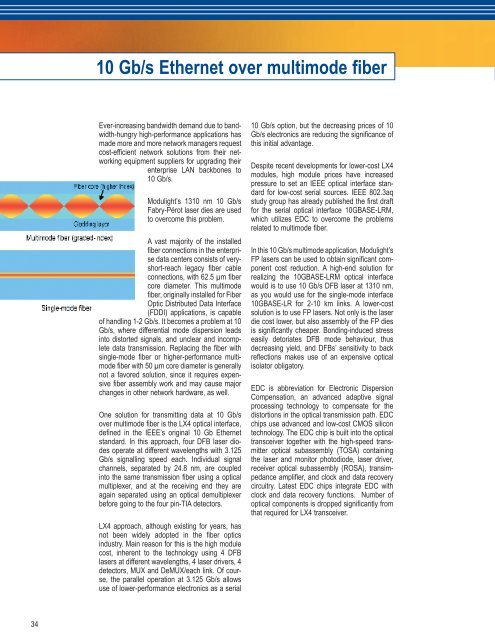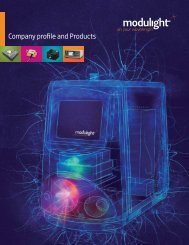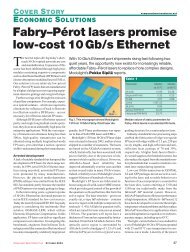COAX products - Modulight
COAX products - Modulight
COAX products - Modulight
You also want an ePaper? Increase the reach of your titles
YUMPU automatically turns print PDFs into web optimized ePapers that Google loves.
10 Gb/s Ethernet over multimode fiberEver-increasing bandwidth demand due to bandwidth-hungryhigh-performance applications hasmade more and more network managers requestcost-efficient network solutions from their networkingequipment suppliers for upgrading theirenterprise LAN backbones to10 Gb/s.<strong>Modulight</strong>’s 1310 nm 10 Gb/sFabry-Pérot laser dies are usedto overcome this problem.A vast majority of the installedfiber connections in the enterprisedata centers consists of veryshort-reachlegacy fiber cableconnections, with 62.5 µm fibercore diameter. This multimodefiber, originally installed for FiberOptic Distributed Data Interface(FDDI) applications, is capableof handling 1-2 Gb/s. It becomes a problem at 10Gb/s, where differential mode dispersion leadsinto distorted signals, and unclear and incompletedata transmission. Replacing the fiber withsingle-mode fiber or higher-performance multimodefiber with 50 µm core diameter is generallynot a favored solution, since it requires expensivefiber assembly work and may cause majorchanges in other network hardware, as well.One solution for transmitting data at 10 Gb/sover multimode fiber is the LX4 optical interface,defined in the IEEE’s original 10 Gb Ethernetstandard. In this approach, four DFB laser diodesoperate at different wavelengths with 3.125Gb/s signalling speed each. Individual signalchannels, separated by 24.8 nm, are coupledinto the same transmission fiber using a opticalmultiplexer, and at the receiving end they areagain separated using an optical demultiplexerbefore going to the four pin-TIA detectors.LX4 approach, although existing for years, hasnot been widely adopted in the fiber opticsindustry. Main reason for this is the high modulecost, inherent to the technology using 4 DFBlasers at different wavelengths, 4 laser drivers, 4detectors, MUX and DeMUX/each link. Of course,the parallel operation at 3.125 Gb/s allowsuse of lower-performance electronics as a serial10 Gb/s option, but the decreasing prices of 10Gb/s electronics are reducing the significance ofthis initial advantage.Despite recent developments for lower-cost LX4modules, high module prices have increasedpressure to set an IEEE optical interface standardfor low-cost serial sources. IEEE 802.3aqstudy group has already published the first draftfor the serial optical interface 10GBASE-LRM,which utilizes EDC to overcome the problemsrelated to multimode fiber.In this 10 Gb/s multimode application, <strong>Modulight</strong>’sFP lasers can be used to obtain significant componentcost reduction. A high-end solution forrealizing the 10GBASE-LRM optical interfacewould is to use 10 Gb/s DFB laser at 1310 nm,as you would use for the single-mode interface10GBASE-LR for 2-10 km links. A lower-costsolution is to use FP lasers. Not only is the laserdie cost lower, but also assembly of the FP diesis significantly cheaper. Bonding-induced stresseasily detoriates DFB mode behaviour, thusdecreasing yield, and DFBs’ sensitivity to backreflections makes use of an expensive opticalisolator obligatory.EDC is abbreviation for Electronic DispersionCompensation, an advanced adaptive signalprocessing technology to compensate for thedistortions in the optical transmission path. EDCchips use advanced and low-cost CMOS silicontechnology. The EDC chip is built into the opticaltransceiver together with the high-speed transmitteroptical subassembly (TOSA) containingthe laser and monitor photodiode, laser driver,receiver optical subassembly (ROSA), transimpedanceamplifier, and clock and data recoverycircuitry. Latest EDC chips integrate EDC withclock and data recovery functions. Number ofoptical components is dropped significantly fromthat required for LX4 transceiver.34





